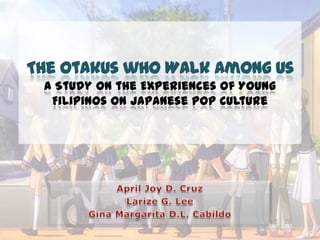
The Otakus Who Walk Among Us Ppt
- 1. The Otakus who Walk Among Us A Study on the Experiences of Young Filipinos on Japanese Pop Culture
- 3. THE PROBLEM How do young Filipino otakus experience Japanese pop culture such as anime and manga?
- 4. General Objectives To determine the manner with which young Filipino otakus experience anime and manga as components of Japanese pop culture
- 5. Specific Objectives • To find out the average demographics and profiles of Filipino youth (otaku) who are into Japanese pop culture • To discover how much media contributes in terms of spreading foreign culture
- 6. Specific Objectives cont... • To discover other influences of anime and manga to young Filipinos through its messages • To know if Japanese pop culture impacts the youth in the sense that they want to change certain aspects of their lifestyle
- 7. Specific Objectives cont... • To determine the factors that influence the Filipino youth into being interested in Japanese pop culture • To classify the Filipino youth under on of the types of adopters of Japanese pop culture
- 9. Diffusion of Innovations Theory • Developed in 1955 • by Everett Rogers
- 10. Diffusion of Innovations Theory • consists of four stages: – Invention – Diffusion – communication – Time – consequences
- 11. Diffusion of Innovations Theory • Adopters are classified into 5 types: – Innovators – Early Adopters – Early Majority – Late Majority – Laggards
- 13. Conceptual Framework • Has a strong relevance to the study • Thoroughly describes the phases of influence of japanese pop culture on its subjects
- 14. Conceptual Framework • Discusses the different degrees of willingness to adopt the pop culture • Though in passing, does not disregard discontinuance and shifts in interest in adopting a pop culture
- 17. Method • triangulation approach • quantitative and qualitative research processes • exploratory type of research design
- 18. Procedures • Distribution of Survey Questionnaires • Facilitating Focus Group Discussions • Conducting Interviews
- 19. Participants • Sample – 16 - 21 year old otakus – 108 participants for the survey – 10 participants for the FGD – 2 interviewees • Sampling Technique – Purposive Sampling
- 20. Participants cont... • Locale – Otaku Expo Reload – UP AME Now Playing: AME Track 10: Rhapsody in the Rain
- 21. Instruments cont... • Survey Questionnaire – Yes/No – Multiple Choice – One Enumeration Type – Self Rating
- 22. Instruments cont... • Focus Group Discussion Guide – Segment I: Introduction – Segment II: General Questions – Segment III: Adopter-Specific Inquiries – Segment IV: Conclusion
- 23. Instruments cont... • Interview Guide – Point-of-View of Organizers – Experiences – Reasons or Goals
- 24. Data Analysis • Tally and Tabulation of results • Note-taking and Transcription of FGDs • Data gathered aligned and correlated with Review of Related Literature
- 26. Statistics • Mean age – participants mostly fell into the age range of 16 - 18 years old • Female to Male ratio – Number of male cosplayers is greater than number of female cosplayers
- 27. Statistics cont... • Status – More private schooled students have the capacity to attend conventions • Area Proximity – Mostly in Metro Manila but considerations were also given to the location of the convention
- 28. Statistics cont... • Work Experience – Background of the event organizers (i.e. length of stay in the organization, nature of work)
- 29. Media, the Bandwagon of Pop Culture • The existence of media and its use as a vehicle which transports pop culture from one place to another (Manzenreiter, 2002) • The accessibility of popular culture through its primary forms or new media (“Anime”, n.d.)
- 30. Pop Culture Messages of Influence • Anime and manga allow opportunities for personal interpretation • Through various studies, it has been verified that anime and manga are carriers of Japan’s culture • The otaku subculture has been recognized as a phenomenon
- 31. Impacts of Japanese Pop Culture • Unique lifestyle of the otaku • Improved interaction with otakus and non-otakus which arise from life lessons picked up from anime and manga
- 32. Impacts of Japanese Pop Culture • Inclination to learn more about Japan • Appeal and preference for Japanese fashion • Desire to cosplay
- 33. Other Factors for Young Filipino’s Interest in Japanese Pop Culture • Manipulation of actual events within anime and manga • The creative display of expression and the unique portrayal of characters
- 34. Other Factors for Young Filipino’s Interest in Japanese Pop Culture • Empathy for the characters • Life lessons learned • Wider range of audience who can enjoy Japanese pop culture
- 35. Types of Adopters • Length and Frequency of Exposure • Conviction and Pride • Self-rating
- 37. Conclusions • Young Filipinos experience Japanese pop culture by exposing themselves to anime and manga • Anime and manga received positively • Anime and manga is not a threat to the youth’s sense of nationalism
- 38. Recommendation • Other forms of pop culture from other countries should be delved into • Further studies on how pop culture can help in promoting other materials (i.e. Filipino komiks)
- 39. Recommendation cont... • Content analysis of popular anime or manga to see how much is reflective of Japan
- 41. 終わり